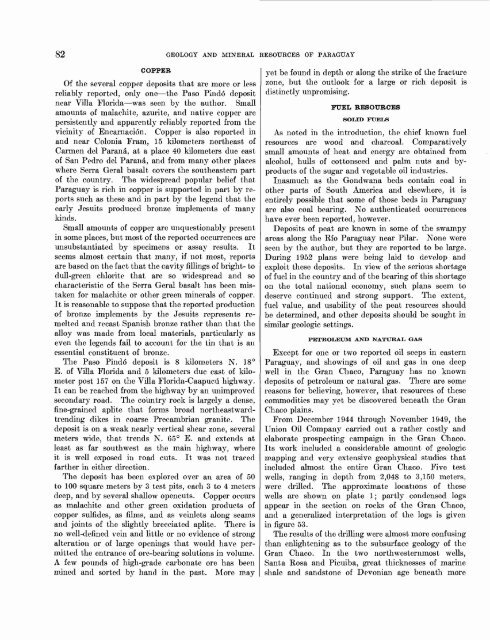Geology and Mineral Resources of Paraguay A Reconnaissance
Geology and Mineral Resources of Paraguay A Reconnaissance
Geology and Mineral Resources of Paraguay A Reconnaissance
- No tags were found...
You also want an ePaper? Increase the reach of your titles
YUMPU automatically turns print PDFs into web optimized ePapers that Google loves.
82 GEOLOGY AND MINERAL RESOURCES OF PARAGUAYCOPPEROf the several copper deposits that are more or lessreliably reported, only one the Paso Plndo depositnear Villa Florida was seen by the author. Smallamounts <strong>of</strong> malachite, azurite, <strong>and</strong> native copper arepersistently <strong>and</strong> apparently reliably reported from thevicinity <strong>of</strong> Encarnacion. Copper is also reported in<strong>and</strong> near Colonia Fram, 15 kilometers northeast <strong>of</strong>Carmen del Parana, at a place 40 kilometers due east<strong>of</strong> San Pedro del Parana, <strong>and</strong> from many other placeswhere Serra Geral basalt covers the southeastern part<strong>of</strong> the country. The widespread popular belief that<strong>Paraguay</strong> is rich in copper is supported hi part by reportssuch as these <strong>and</strong> in part by the legend that theearly Jesuits produced bronze implements <strong>of</strong> manykinds.Small amounts <strong>of</strong> copper are unquestionably presentin some places, but most <strong>of</strong> the reported occurrences areunsubstantiated by specimens or assay results. Itseems almost certain that many, if not most, reportsare based on the fact that the cavity fillings <strong>of</strong> bright- todull-green chlorite that are so widespread <strong>and</strong> socharacteristic <strong>of</strong> the Serra Geral basalt has been mistakenfor malachite or other green minerals <strong>of</strong> copper.It is reasonable to suppose that the reported production<strong>of</strong> bronze implements by the Jesuits represents remelted<strong>and</strong> recast Spanish bronze rather than that thealloy was made from local materials, particularly aseven the legends fail to account for the tin that is anessential constituent <strong>of</strong> bronze.The Paso Pind6 deposit is 8 kilometers N. 18°E. <strong>of</strong> Villa Florida <strong>and</strong> 5 kilometers due east <strong>of</strong> kilometerpost 157 on the Villa Florida-Caapucii highway.It can be reached from the highway by an unimprovedsecondary road. The country rock is largely a dense,fine-grained aplite that forms broad northeastwardtrendingdikes in coarse Precambrian granite. Thedeposit is on a weak nearly vertical shear zone, severalmeters wide, that trends N. 65° E. <strong>and</strong> extends atleast as far southwest as the main highway, whereit is well exposed in road cuts. It was not tracedfarther in either direction.The deposit has been explored over an area <strong>of</strong> 50to 100 square meters by 3 test pits, each 3 to 4 metersdeep, <strong>and</strong> by several shallow opencuts. Copper occursas malachite <strong>and</strong> other green oxidation products <strong>of</strong>copper sulfides, as films, <strong>and</strong> as veinlets along seams<strong>and</strong> joints <strong>of</strong> the slightly brecciated aplite. There isno well-defined vein <strong>and</strong> little or no evidence <strong>of</strong> strongalteration or <strong>of</strong> large openings that would have permittedthe entrance <strong>of</strong> ore-bearing solutions in volume.A few pounds <strong>of</strong> high-grade carbonate ore has beenmined <strong>and</strong> sorted by h<strong>and</strong> in the past. More mayyet be found in depth or along the strike <strong>of</strong> the fracturezone, but the outlook for a large or rich deposit isdistinctly unpromising.FUEL RESOURCESSOLID FUELSAs noted in the introduction, the chief known fuelresources are wood <strong>and</strong> charcoal. Comparativelysmall amounts <strong>of</strong> heat <strong>and</strong> energy are obtained fromalcohol, hulls <strong>of</strong> cottonseed <strong>and</strong> palm nuts <strong>and</strong> byproducts<strong>of</strong> the sugar <strong>and</strong> vegetable oil industries.Inasmuch as the Gondwana beds contain coal inother parts <strong>of</strong> South America <strong>and</strong> elsewhere, it isentirely possible that some <strong>of</strong> those beds in <strong>Paraguay</strong>are also coal bearing. No authenticated occurrenceshave ever been reported, however.Deposits <strong>of</strong> peat are known in some <strong>of</strong> the swampyareas along the Bio <strong>Paraguay</strong> near Pilar. None wereseen by the author, but they are reported to be large.During 1952 plans were being laid to develop <strong>and</strong>exploit these deposits. In view <strong>of</strong> the serious shortage<strong>of</strong> fuel in the country <strong>and</strong> <strong>of</strong> the bearing <strong>of</strong> this shortageon the total national economy, such plans seem todeserve continued <strong>and</strong> strong support. The extent,fuel value, <strong>and</strong> usability <strong>of</strong> the peat resources shouldbe determined, <strong>and</strong> other deposits should be sought insimilar geologic settings.PETROLEUM AND NATURAL GASExcept for one or two reported oil seeps in easternParaguajr, <strong>and</strong> showings <strong>of</strong> oil <strong>and</strong> gas in one deepwell in the Gran Chaco, <strong>Paraguay</strong> has no knowndeposits <strong>of</strong> petroleum or natural gas. There are somereasons for believing, however, that resources <strong>of</strong> thesecommodities may yet be discovered beneath the GranChaco plains.From December 1944 through November 1949, theUnion Oil Company carried out a rather costly <strong>and</strong>elaborate prospecting campaign in the Gran Chaco.Its work included a considerable amount <strong>of</strong> geologicmapping <strong>and</strong> very extensive geophysical studies thatincluded almost the entire Gran Chaco. Five testwells, ranging in depth from 2,048 to 3,150 meters,were drilled. The approximate locations <strong>of</strong> thesewells are shown on plate 1; partly condensed logsappear in the section on rocks <strong>of</strong> the Gran Chaco,<strong>and</strong> a generalized interpretation <strong>of</strong> the logs is givenin figure 53.The results <strong>of</strong> the drilling were almost more confusingthan enlightening as to the subsurface geology <strong>of</strong> theGran Chaco. In the two north westernmost wells,Santa Kosa <strong>and</strong> Picuiba, great thicknesses <strong>of</strong> marineshale <strong>and</strong> s<strong>and</strong>stone <strong>of</strong> Devonian age beneath more
















